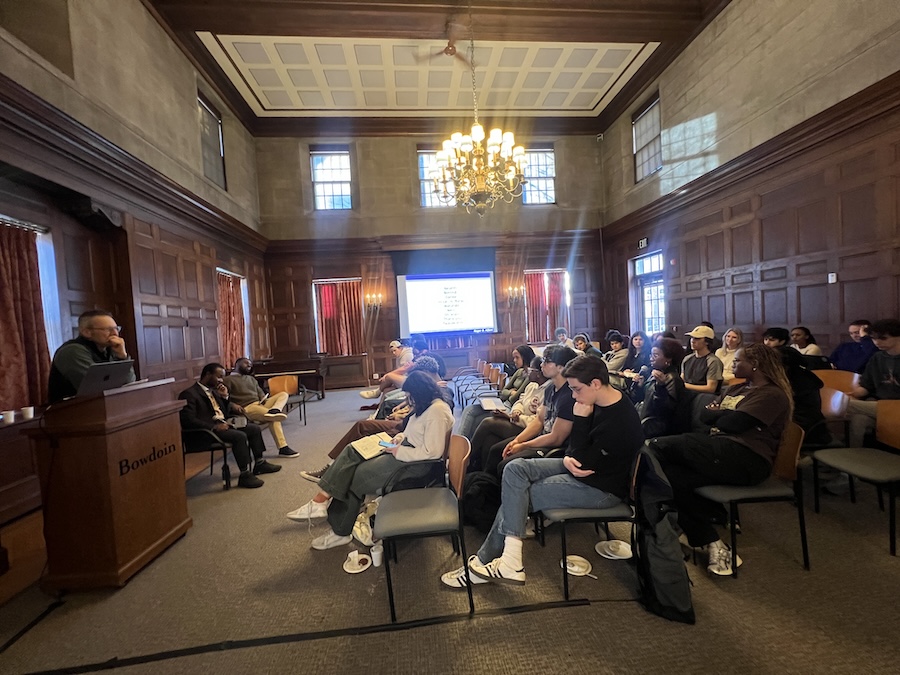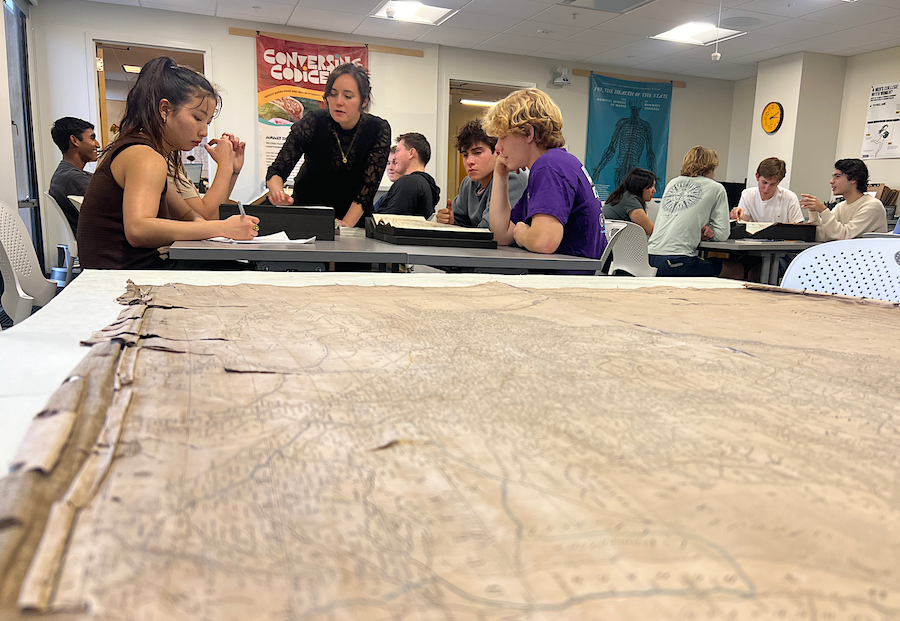Bowdoin Historian Questions the ‘Wolves’ the Pilgrims Met
By Rebecca Goldfine
In the fall of 1620, a pilgrim named John Goodman walked a short ways from Plymouth Colony with his dog, a little Spaniel. On his walk, he encountered two fierce animals that chased his dog. Goodman defended his pet with a stick, and the “wolves” sat back on their tails, “grinning at him a good while” before they went on their way.
This anecdote, reported in the account William Bradford’s Of Plimoth Plantation in New England, piqued historian Strother Roberts’ interest, resulting in a new research project that could change how we think about pilgrims, Native Americans, animals, and pets.
In a recent faculty seminar at Bowdoin, Roberts spoke about the Goodman incident, pointing out, “This is not how wolves behave.” Native Americans and early settlers heavily hunted wolves; consequently, Roberts argued, one would expect wolves to behave skittishly in the presence of humans. “We would expect them to hunker down, perhaps snarl, lower their heads, raise the fur on their backs, and slink away. That’s not what we see.”
Roberts proposes that maybe these were not wolves at all, but instead were domesticated dogs that had belonged to the Native people who once lived in the region. “Perhaps they were dogs looking for a new home and a new master,” he said.
“The ecological impact of pre-modern dogs and working dogs, loose dogs, and feral dogs remains largely a mystery,” in pre-modern North America as well as around the world.
—Strother Roberts, assistant professor of history
Roberts studies early US history, focusing on colonization. His curiosity about Native American dogs began with findings he made while writing his first book, Atlantic Economy, Colonial Ecology: Transforming Nature in Early Modern New England. That book, currently under review at the University of Pennsylvania Press, is an environmental history of New England. It looks at how New Englanders, both colonists and natives, became vital sources of desirable commodities — e.g., beaver pelts, grain, and barreled pork and beef — to the West Indies and Europe, and how the regional environment was transformed in this process.
After completing Atlantic Economy, Colonial Ecology, Roberts turned his attention to dogs, which he describes as being for centuries the “most abundant nonhuman large predator in the world.” Despite their big numbers, the “ecological impact of pre-modern dogs and working dogs, loose dogs, and feral dogs remains largely a mystery,” in pre-modern North America as well as around the world.
In addition, much of what has been written about 17th-century Native American dogs seems to be inaccurate, or at least contradictory. Early English settlers tended to describe the indigenous dogs they encountered as wolf-like and barely domesticated. This interpretation has been repeated by modern historians, according to Roberts. “What we see is English observers or historians putting out the idea that Indians don’t have fully domesticated dogs” and are instead “raising hybrid creatures,” he said. “Basically they are showing their cultural prejudice and suggesting that wild men must keep company with wild animals.”
But there are alternative views. Farther north, French colonial officials and missionaries living among Native people in the 1600s reported a different story. While they agreed with their English counterparts that indigenous dogs howled instead of barked and had erect ears and pointy snouts, much like wolves, they believed these canines were indeed tame. A French friar in the 1620s who lived with the Hurons described people eating dogs and using them as hunting aids. “What we get here are dogs as livestock,” Roberts said. “They provided a meat source, like cattle, goats, sheep, swine, etc. They…hauled loads and pulled sledges, like horses and oxen, and most importantly, they helped humans in the hunt just like horses did in Europe.”
Returning to the Plymouth colony and John Goodman’s encounter with “wolves,” Roberts argued it’s possible the dogs had been left on their own after their Native masters succumbed to a mysterious epidemic. The English founded the Plymouth colony in 1620 on a village abandoned by the Wampanoag after as many as 75 percent to 90 percent of the Natives died from an unknown disease by 1619. “Those who survived would have faced famine at the end of the epidemic and would have fled the village, seeking refuge in other Wampanoag villages,” Roberts said. It’s possible some of their dogs may have been cast out and gone feral.
As Roberts continues researching pre-modern dogs and the role they played in Native civilizations in northeastern North America, he said he’s particularly interested in better understanding the impact the dogs must have had on the environment. He estimates that in Wabanaki region—which covers all of New England and the Canadian Maritimes—there may have been between 30,000 to over 100,000 domesticated dogs living with Native tribes circa 1600.
“What were their influence on wildlife and the natural environment?” he asked. “And does any of this change our understanding of early American perceptions of wilderness and civilization?”



